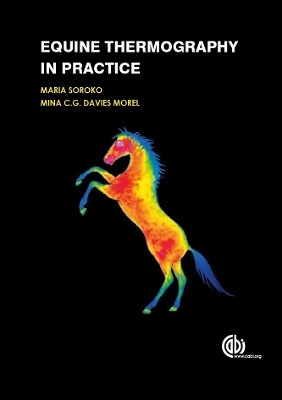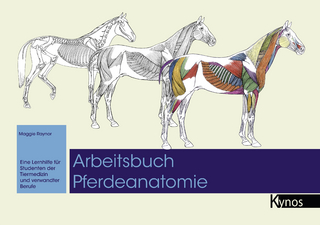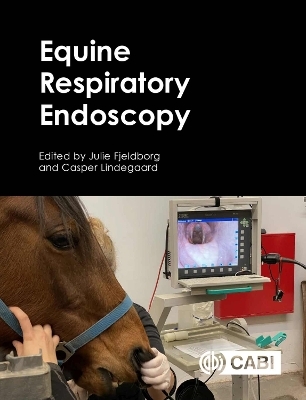
Equine Thermography in Practice
CABI Publishing (Verlag)
978-1-78064-787-6 (ISBN)
- Titel ist leider vergriffen;
keine Neuauflage - Artikel merken
Evidence-based and yet very practical, Equine Thermography in Practice discusses how to use the tool in the diagnosis of equine musculoskeletal injuries and what the user can expect to see in normal versus injured horses giving guidelines for best practice. The book builds from basics covering the principles of thermography and then its applications in equine veterinary medicine and the role of the technique regarding the equestrian athlete as well as in rehabilitation. Extensively illustrated and thoroughly referenced, this book is indispensable to novice and experienced practitioners using the technique, including: equine veterinarians and equine physiotherapists and body work practitioners.
Maria Soroko (Author) Dr. Maria Soroko gained her PhD in Agricultural Science with a specialisation in Animal Husbandry from the University of Environmental and Life Sciences of Wroclaw, Department of Horse Breeding and Equestrian Studies in 2013. Her Master's degree in Equine Science was completed in 2010 at the Institute of Biological, Environmental and Rural Sciences, Aberystwyth University, Wales, United Kingdom. Since 2008 the author has practiced thermography extensively in equine physiotherapy and in veterinary medicine, cooperating with veterinarians, horse breeders and trainers. She is also the owner and director of the company "Equine Massage - Maria Soroko", www.eqma.pl, which offers equine rehabilitation and thermography services, professional courses and workshops associated with horse rehabilitation and the application of thermography in veterinary and sports medicine. Maria conducts research on the application of thermography in sport and racing horses, authoring numerous original publications and overview papers. She is also a member of the European Association of Thermology. She has many years of experience in equine physiotherapy, achieving qualifications as an Equine Body Worker in sport massage and remedial therapy. Maria is also a riding instructor at the British Horse Society. Her skills and experience were achieved both in Europe and Australia. Mina C G Davies Morel (Author) Mina studied for her degree in Animal Science in Nottingham University. After going on to study for her PhD at Aberystwyth University she was awarded the Animal Health Trust Wooldridge farm livestock personal post-doctoral scholarship to continue her research at the University. As a member of staff of the Welsh Agricultural College she set up the Equine Department and courses. Since joining the University Mina has headed up the equine courses, and over time has developed and managed as well as taught on a wide range of equine science and studies courses, ranging from Foundation degree to MSc. Mina is a Reader in Animal Reproduction and has particular responsibility for postgraduate students and for many years has been Course Director of the MSc Equine Science and MSc Animal Science courses in addition to supervising research students. Mina attained a University teaching excellence award in 2010 and a Higher Education Academy Senior Fellowship Award in 2014. Mina has taught on and held external examiner/adviser positions in numerous Universities in UK and abroad. Mina has published widely in the scientific and popular press in addition to being the author of 3 text books. Mina has been a horse owner and rider since childhood.
: About the Authors : Acknowledgements : Glossary : Introduction 1: Principles of Equine Thermography 1.1: Thermography 1.2: Methods for measuring infrared radiation 1.3: Principles of infrared radiation 1.4: The thermographic image 1.5: Thermographic imaging technology 1.6: Thermography as a diagnostic tool in equine medicine 1.7: Normal body surface temperature distribution of the horse 1.7.1: Anatomical structure 1.7.2: Subcutaneous tissue 1.7.3: Muscle tissue 1.7.4: Hair coat 1.7.5: Season of the year 2: Fundamentals of Thermographic Examination 2.1: Procedures for thermographic examination, including the impact of environmental conditions 2.1.1: Preparing a room for thermographic examination 2.1.2: Preparing a horse for thermographic examination 2.1.3: Interview with the horse owner 2.2: Taking images of the horse 2.2.1: Thermographic protocol 2.2.2: Correct positioning of the horse and camera 2.2.3: Sample thermographic images 2.2.3.1: Lateral aspect of the horse 2.2.3.2: Distal forelimbs 2.2.3.3: Distal hindlimbs 2.2.3.4: Shoulder area 2.2.3.5: Croup area 2.2.3.6: Chest area 2.2.3.7: Neck area 2.2.3.8: Head area 2.2.3.9: Back area 2.3: Most frequently made errors in thermographic imaging 3: Interpretation of Thermographic Images and the Normal Superficial Temperature Distribution of the Horse 3.1: Thermography analysis for veterinary or prophylactic purposes 3.2: Analysis of symmetry and repeatability of body surface temperature distribution in contralateral body areas of the horse 3.2.1: Determination of body surface temperature differences between symmetrical body areas or regions of interest (ROIs) 3.2.2: Determination of body surface temperature along linear ROIs or at specific points on the body surface 3.2.3: Interpretation of thermograms 3.2.3.1: Distal forelimbs and hindlimbs 3.2.3.2: Back area 3.2.3.3: Shoulder area 3.2.3.4: Neck area 3.2.3.5: Head area 3.2.3.6: Croup area 3.2.3.7: Chest area 3.2.4: What should be considered in thermographic image interpretation? 3.2.5: Thermographic reports 4: Development of Equine Thermography and its Use in Equestrianism 4.1: Development of thermography in equine veterinary medicine 4.2: Use of thermography in equestrianism 4.2.1: Use of thermography to monitor horse welfare 4.2.2: Use of thermography to assess saddle fit 4.2.3: Use of thermography to assess hoof function 4.3: Use of thermography to assess racing performance 5: Use of Thermography in Physiotherapy 5.1: Thermography applications in equine physiotherapy 5.2: Manual assessment of the horse 5.2.1: Head area 5.2.1.1: Skeletal system 5.2.1.2: Muscular system 5.2.1.3: Indicators of a problem 5.2.1.4: Manual and visual assessment of the head 64 5.2.2: Neck area 5.2.2.1: Skeletal system 5.2.2.2: Muscular system 5.2.2.3: Indicators of a problem 5.2.2.4: Manual and visual assessment of the neck 5.2.3: Forelimb area 5.2.3.1: Skeletal system 5.2.3.2: Muscular system 5.2.3.3: Indicators of a problem 5.2.3.4: Manual and visual assessment of the forelimb 5.2.4: Back area 5.2.4.1: Skeletal system 5.2.4.2: Muscular system 5.2.4.3: Indicators of a problem 5.2.4.4: Manual and visual assessment of the back 5.2.5: Hindlimb area 5.2.5.1: Skeletal system 5.2.5.2: Muscular system 5.2.5.3: Indicators of a problem 5.2.5.4: Manual and visual assessment of the hindlimb 5.3: Muscle function 5.3.1: Linked muscle function 5.3.2: Antagonistic muscle function 5.3.3: Diagonal limb muscle function 5.4: Dysfunction of the musculoskeletal system: summary 6: Recommendations for Thermography Application : References : Appendix 1: Equine Thermographic Examination Questionnaire : Index
| Erscheinungsdatum | 15.06.2016 |
|---|---|
| Verlagsort | Wallingford |
| Sprache | englisch |
| Maße | 172 x 244 mm |
| Gewicht | 467 g |
| Themenwelt | Veterinärmedizin ► Pferd |
| ISBN-10 | 1-78064-787-5 / 1780647875 |
| ISBN-13 | 978-1-78064-787-6 / 9781780647876 |
| Zustand | Neuware |
| Informationen gemäß Produktsicherheitsverordnung (GPSR) | |
| Haben Sie eine Frage zum Produkt? |
aus dem Bereich


